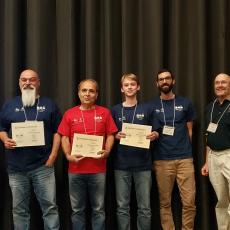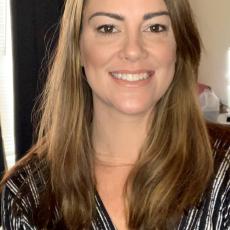CS M01: Intro Computer Science Units: 3
Students will learn the overview of the main concepts in computer science. Such as data storage, binary, Octal, hexadecimal numbers, logic circuits, Von Neumann architecture, programming languages, operating systems, algorithms, software engineering, data abstraction, computer programming (Intro to C++), networking and Internet (how to design a web site using HTML), database systems, ethical issues, and data structures.
Programs referencing this course: Moorpark College General Education Requirements
Music Technology
Geographic Information Systems
CS M125: Programming Concepts and Methodology I Units: 3
Formerly known as: CS M10A
Provides an introduction to the C++ programming language. Covers the basic programming concepts such as syntax, semantics, algorithms, data types, input/output, assignment statements, conditional statements, loop structures, arrays, functions, strings, file operations, pointers, and Object-Oriented Programming.
Advisories on Recommended Preparation: CS M01 and basic computer usage knowledge and MATH M06 or MATH M07
Programs referencing this course:
Associate in Science in Computer Science for Transfer
CS M135: Programming Concepts and Methodology II Units: 3
Formerly known as: CS M10B and CSM20 together, so it is a compressed CSM10B and CSM20
Covers the object oriented programming concepts such as inheritance, polymorphism, abstract data type (ADT), operator overloading, recursion, exception handling, templates, containers, data structures (linked list, stack, queue, binary tree, binary search tree, heap, graphs), and the associated algorithms.
Prerequisites: CS M125 or CSM10A
Programs referencing this course:
Associate in Science in Computer Science for Transfer
CS M145: Computer Architecture & Organization Units: 3
CSM145 is the new version of CSM30
Covers boolean algebra, logic gates, and flip-flops, computer architecture, computer organization, basic digital circuits (full adders, half-adders, decoders, multiplexers, registers and ALU's), and 80x86 assembly language programming including mnemonics, registers, different operand types and addressing modes. Studies the mapping of statements and constructs in a high-level language into sequences of machine instructions. Discusses the internal representation of simple data types, structures, and examines numerical computation, data representation errors, procedural errors, data representation including number systems, signed & unsigned
Prerequisites: CSM125 or CSM10A Applies to Associate Degree
Programs referencing this course:
Associate in Science in Computer Science for Transfer
CS M155: Discrete Structures Units: 3
Covers functions, relations, sets, basic logic, proof techniques, basics of counting (multiplication, factorial, permutation, combination, Pigeonhole theorem), graphs, trees, discrete probability (addition, multiplication, complement rules), and conditional probability. Methods of proof including direct and indirect proof forms, proof by contradiction, and mathematical induction. Covers number theory, cryptography, and linear congruence equations. Applies to Associate Degree. C-ID: COMP 152
Prerequisites: (CSM125 or CS M10A) and MATH M07 or (MATH M05 and MATH M06)
Programs referencing this course: IGETC
Moorpark College General Education Requirements
Associate in Science in Computer Science for Transfer
CSU GE-BREADTH
CS M10P: Python Programming Units: 4
Covers the fundamentals of computer programming: basic data types, switching and looping constructs, functions, modules, file processing, exception handling, recursion, object oriented programming, inheritance, polymorphism, arrays, lists, sets, dictionary, GUI, basic input and output, both interactive and with files. Explains some principles of algorithm design and analysis as well as techniques for testing programs. Applies to Associate Degree.
Programs referencing this course:
Computer Programming, Web Design, Geographic Information Systems
CS M10J: Intro to Comp Prog Using Java Units: 4
Uses the Java computer language to introduce basic programming concepts such as algorithms, data types, and control structures (conditional statements and loops), strings & characters, debugging, documentation, exception handling, templates, file processing, object-oriented programming, inheritance, polymorphism, graphical user interface (GUI), applets, recursion, and creating multimedia programs. Applies to Associate Degree.
Advisories on Recommended Preparation
CS M01 and basic computer usage knowledge or (CSM125 or CS M10A) and MATH M06 or MATH M07
Programs referencing this course:
Moorpark College General Education Requirements
Music Technology, Computer Programming, Web Design
CS M10DB: Intro to Database Management Systems & Applications Units: 3
Introduces modern database concepts while emphasizing the relational database model. Includes such topics as design methodologies, normalization of tables to reduce redundancies, supertypes and subtypes to reduce nulls, data integrity, referential integrity, and using locks and other techniques for concurrency control in a multi-user database. Describes the factors that should be balanced during the design of a database. Documents databases, entity relationship diagrams, relational schemas, and data dictionaries are described. Applies the principles by performing exercises using MS SQL Server, MySQL, or other database management system. Uses SQL and other languages to create and fill tables, retrieve data, and manipulate it by stored programs
Programs referencing this course: Computer Programming, Web Design
CS M10DS: Intro to Data Science Units: 3
Provides a comprehensive introduction to the field of Data Science. Studies machine learning which is a type of artificial intelligence (AI) that provides systems the ability to automatically learn and improve from experience without being explicitly programmed. Distinguishes supervised and unsupervised machine learning (Data Mining) algorithms. Studies the emergence of massive datasets containing millions or even billions of observations which provides the primary incentive for the field, such data sets arise, for instance, in large-scale retailing, telecommunications, astronomy, engineering, health, and internet social media. Provides the key knowledge of data development, management, statistical analysis, data visualization, and inference.
Recommended Preparation: CS M10P or CS M10A or CS M125 or CS M10J
Programs referencing this course: Data Science Certificate
CS M15W: Client-Side Web Development Using HTML/JavaScript Units: 3
Introduces students to different methodologies used to develop webpages. Explains the syntax and semantics of Hyper Text Markup Language (HTML). Introduces the different tools to create dynamic and static webpages using Cascading Style Sheets (CSS) and JavaScript. Develops written, oral communication and analysis skills in students so they can review and critique web content from a developer's perspective.
Programs referencing this course: Web Design and Web Development
CS M16PH: Server-Side Development using PHP Units: 3
Applies best coding practices using Personal Home Page (PHP) language. Introduces different techniques to connect client-side code hypertext markup language (HTML) with databases using queries. Performs different input/output (I/O) operations to manipulate data. Enables students to manage sessions and track user activities among different pages using sessions, cookies and database queries.
Programs referencing this course: Web Design and Web Development
CS M10R: Intro to R Programming Units: 3
Introduces computer programming and algorithm design using the R programming language. Covers an introduction to R, from installation to most of the statistical concepts, and machine learning. Includes the fundamentals of computer programming concepts: basic data types, variables, if-else, loops, functions, vectors, objects, matrices, arrays, data frames, lists, factors, basic input, data visualization, and output with files. Explains some principles of algorithm design and analysis as well as techniques for testing programs.
Recommended Preparation: CS M10P or CS M10A or CS M125 or CS M10J
Programs referencing this course: Data Science Certificate
CS M10ML: Cloud Data Science and Machine Learning Units: 2
Catalog Course Description Provides a Cloud based introduction to the various tools and services available from Amazon Web Services (AWS) cloud platform for data science analysis. Studies how data science and machine learning is used process vast amounts of collected data to derive predictive analysis. Course will use Amazon Web Services (AWS) Academy to learn about cloud based data science tools, and cloud based services. Data science tools include SageMaker and Amazon Forecast. Computer Vision includes Amazon Rekognition, Amazon Ground Truth, image and video processing and other AWS Data Science services. Natural Language processing includes Amazon Polly, Amazon Comprehend, and Amazon Translate
Programs referencing this course: Data Science Certificate


